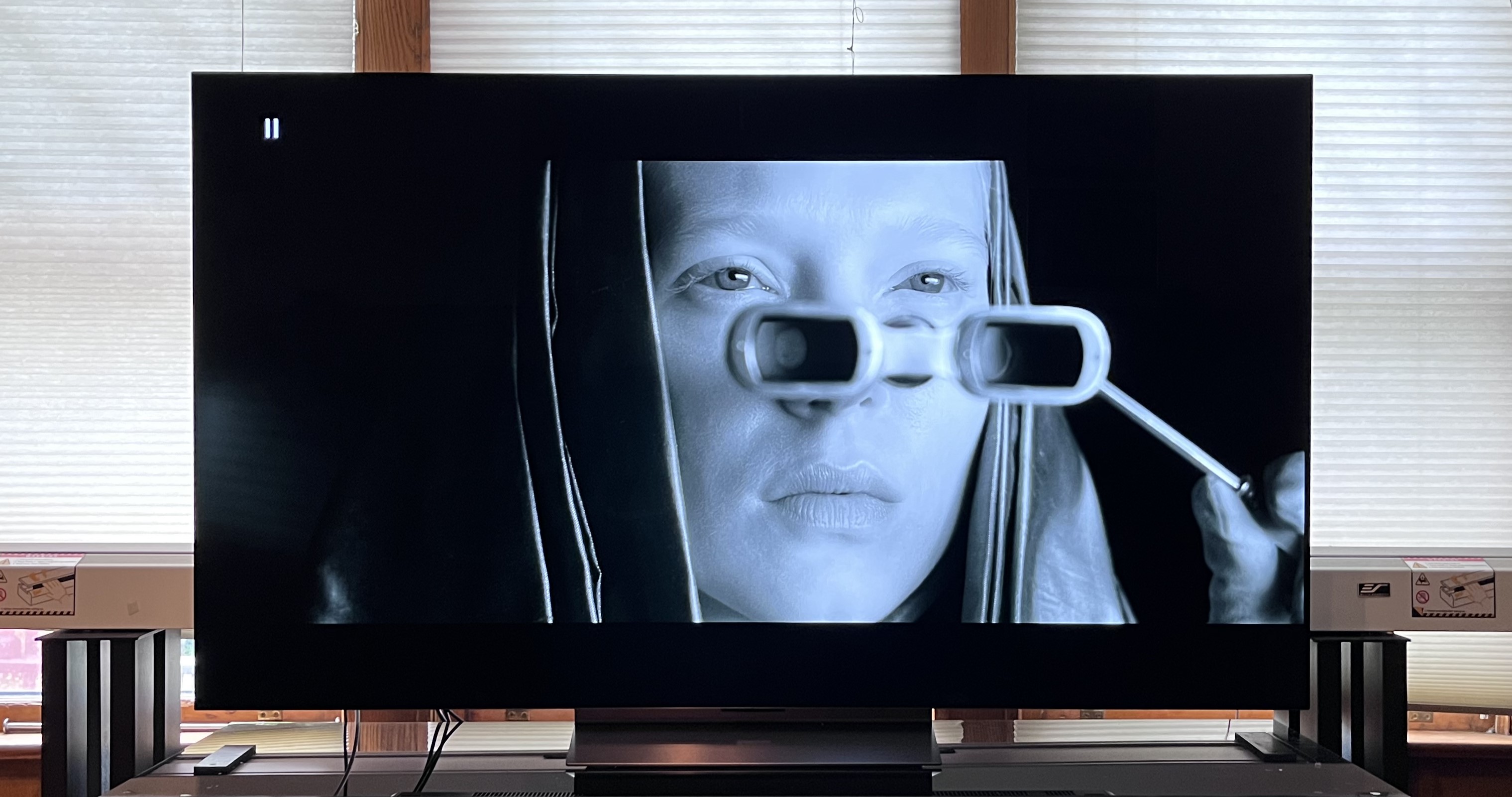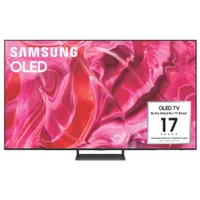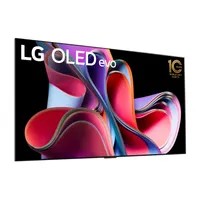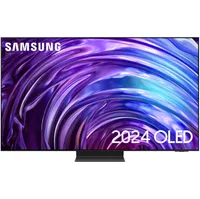TechRadar Verdict
The bright, punchy picture put out by LG’s mid-range C4 OLED TV captivated us when we first saw it, and now that we’ve completed a full review we can confirm that it does improve on last year’s also-impressive LG C3. With the C4, you get a TV with refined picture quality, a sturdy design, and key gaming features including 4K 144Hz support. It’s not the cheapest TV option by a long shot, but movie fans and gamers alike will find plenty to love about the LG C4.
Pros
- +
Better than average OLED brightness
- +
Great gaming features including 144Hz support
- +
New Dolby Vision Filmmaker Mode
Cons
- -
No HDR10+ support
- -
Just-average sound quality
Why you can trust TechRadar
LG C4 OLED TV: Two-minute review
The LG C4 OLED TV continues the company’s C-range tradition of providing premium features and performance at a more affordable price than the flagship G-range. At $2,699.99 / £2,699 / AU$4,299, the 65-inch C4 I tested is still a fairly pricey TV, but it comes with enhancements that make it worth considering over the still-available LG C3 OLED from 2023.
LG’s new Alpha 9 AI Processor 4K Gen7 processor is used in the LG C4 OLED TV, and it provides a Brightness Booster feature that delivers a real brightness advantage over the LG C3. The new processor also works to improve upscaling of HD sources and there’s now a Dolby Vision Filmmaker mode that presents movies in Dolby Vision HDR as the director intended without having to visit menus and change picture settings. Like other examples of the best TVs, the C4 series supports the HDR10 and HLG high dynamic range formats along with Dolby Vision.
Audio also gets an upgrade from LG’s new processor, with the TV’s AI Sound Pro mode providing virtual 9.1.2-channel upmixing of soundtracks. The C4’s built-in speakers deliver more than adequate sound, but there are also features such as Wow Orchestra and Wow Cast designed to work specifically with LG’s family of soundbars.
LG OLEDs have always counted among the best gaming TVs, and the LG C4 has the expected four HDMI 2.1 ports that provide 4K 120Hz pass-through along with VRR, ALLM, and Quick Media Switching (more on this later). The C4 is also 144Hz-certified by Nvidia, making it a great choice for both PC and Xbox Series X and PlayStation 5 console gaming.
The LG C4’s webOS 24 smart TV interface has a more streamlined appearance than last year’s webOS 23 and now supports up to 10 individual profiles that can be automatically activated by the user’s voice. Quick Cards let you organize apps around Games, Music, Home Hub, Sports, and Home Office themes, with Games providing cloud-based gaming from services like Nvidia GeForce Now and Amazon Luna, and Home Hub letting you link up Matter-supported devices to be controlled by the TV.
LG’s design for the C4 incorporates a sturdy aluminum pedestal stand with connections side-mounted on the back of the TV. Among these, there’s no built-in ATSC 3.0 tuner for receiving next-gen TV broadcasts in the US, which is disappointing. The TV comes with LG’s innovative Magic Remote, one that uniquely allows for point-and-click and scrolling onscreen control and navigation.
The LG C4 OLED may be more expensive than many other TV options on the market, but if you’re a movie fan or gamer looking for a top-notch set at a less-than-flagship price, I can highly recommend it.
Sign up for breaking news, reviews, opinion, top tech deals, and more.
LG C4 OLED TV review: Price and release date
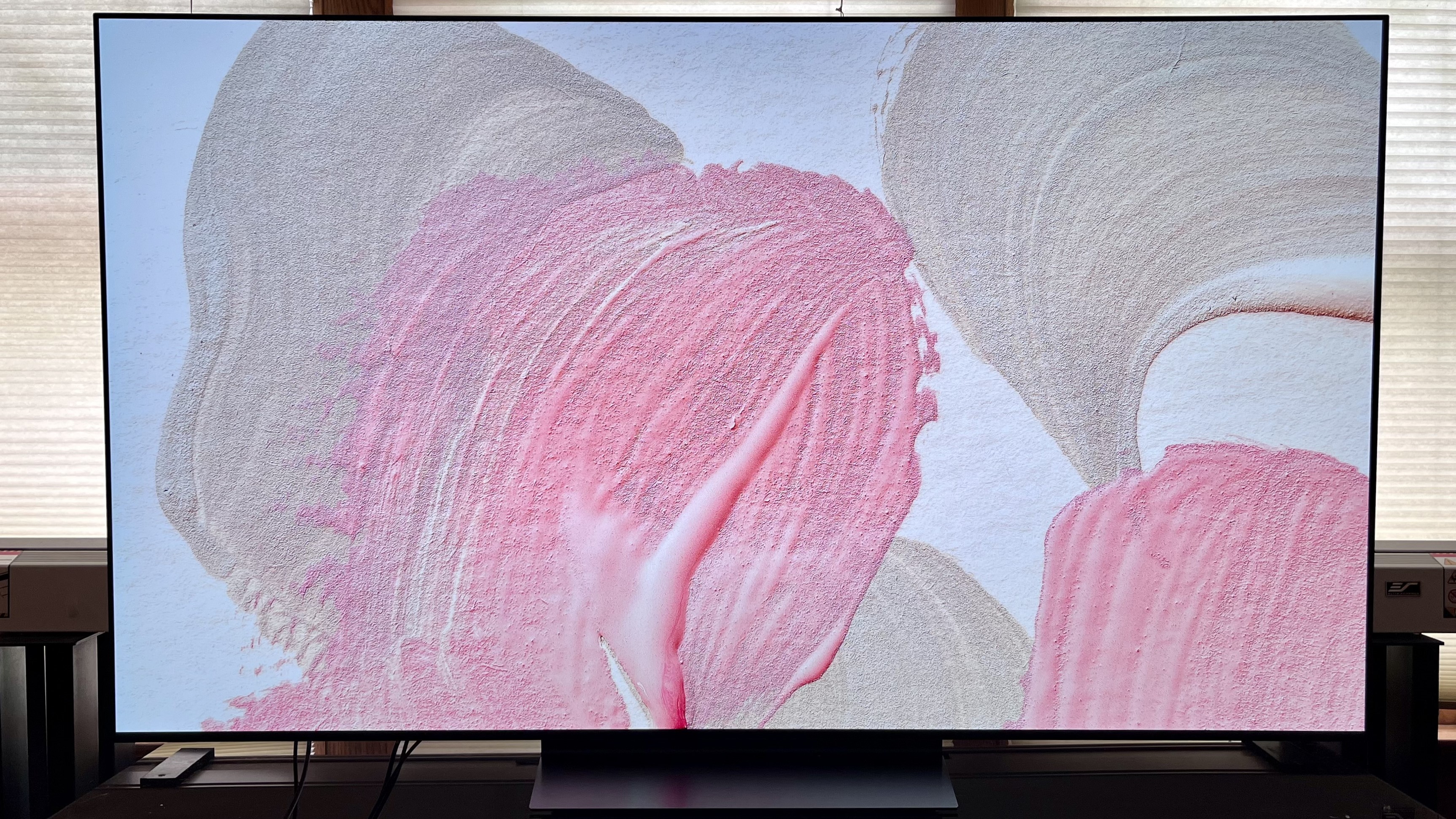
- Release date: March 10, 2024
- 42-inch: $1,499.99 / £1,399 / AU$2,199
- 48-inch: $1,599.99 / £1,499 / AU$2,499
- 55-inch: $1,999.99 / £1,899 / AU$3,299
- 65-inch: $2,699.99 / £2,699 / AU$4,299
- 77-inch: $3,699.99 / £3,799 / AU$5,999
- 83-inch: $5,399.99 / £5,999 / AU$7,999
LG’s C4 OLED TV was released in early March 2024 in screen sizes ranging from 42 to 83 inches. The LG C4 is the company’s midrange OLED series, slotting between the entry-level LG B4 series and the flagship LG G4 and M4 series TVs.
Prices for the entire LG C4 series are slightly higher than last year’s LG C3 series models. The main competition for the C4 series is the Samsung S90D series OLED TVs, which are also sold in 42- to 83-inch screen sizes and have similar pricing. As this review was published, the LG C4 series had already received its first price cuts in the US.
LG C4 OLED TV review: Specs
| Screen type: | OLED |
| Refresh rate: | 120Hz |
| HDR support: | Dolby Vision, HDR10, HLG |
| Audio support: | Dolby Atmos, DTS |
| Smart TV: | webOS 24 |
| HDMI ports: | 4x HDMI 2.1 |
| Built-in tuner: | ATSC 1.0 (US) |
LG C4 OLED TV review: Benchmark results
LG C4 OLED TV review: Features

- New Alpha 9 AI Processor 4K Gen7 processor with Brightness Booster
- New Dolby Vision Filmmaker mode
- Four HDMI 2.1 inputs with 4K 120Hz and 144Hz pass-through
LG C4 OLED TVs have a new Alpha 9 AI Processor 4K Gen7 processor with a Brightness Booster feature to maximize HDR highlights. This processor also helps with 4K picture upscaling and can upmix sound to a virtual 9.1.2 Dolby Atmos format. Another important processor-related feature debuting in LG’s C4 and G4 series OLEDs is lossless wireless Dolby Atmos transmission, which requires a compatible LG soundbar.
HDR format support on the LG C4 includes Dolby Vision, HDR10, and HLG. Dolby Vision IQ is also supported and it has a new Dolby Vision Filmmaker mode that disables motion smoothing in its default settings.
The LG C4’s four HDMI 2.1 inputs support 4K 120Hz and 144Hz pass-through, VRR, ALLM, and Quick Media Switching (QMS), a feature that allows for seamless frame rate matching when connected to a source that also supports QMS such as an Apple TV 4K. For viewers in the US, the TV’s built-in ATSC 1.0 tuner is a step down from the ATSC 3.0 version found in other new TVs from Sony, TCL, and Hisense. Both AirPlay and Chromecast built-in are supported for wireless streaming from devices, and you can use Alexa or Google Assistant for voice commands.
LG’s webOS 24 smart interface is used for streaming and browsing shows and movies on the TV, and there’s now support for cloud gaming as well. All of the usual app suspects are available, and there’s a new, more refined version of LG’s Quick Cards layout with options for Games, Music, Home Hub, Sports, and Home Office. Quick Cards act as a repository for your apps, and the Home Hub lets you connect Matter-supported devices, which can be controlled directly from the TV.
- Features Score: 5/5
LG C4 OLED TV review: Picture quality
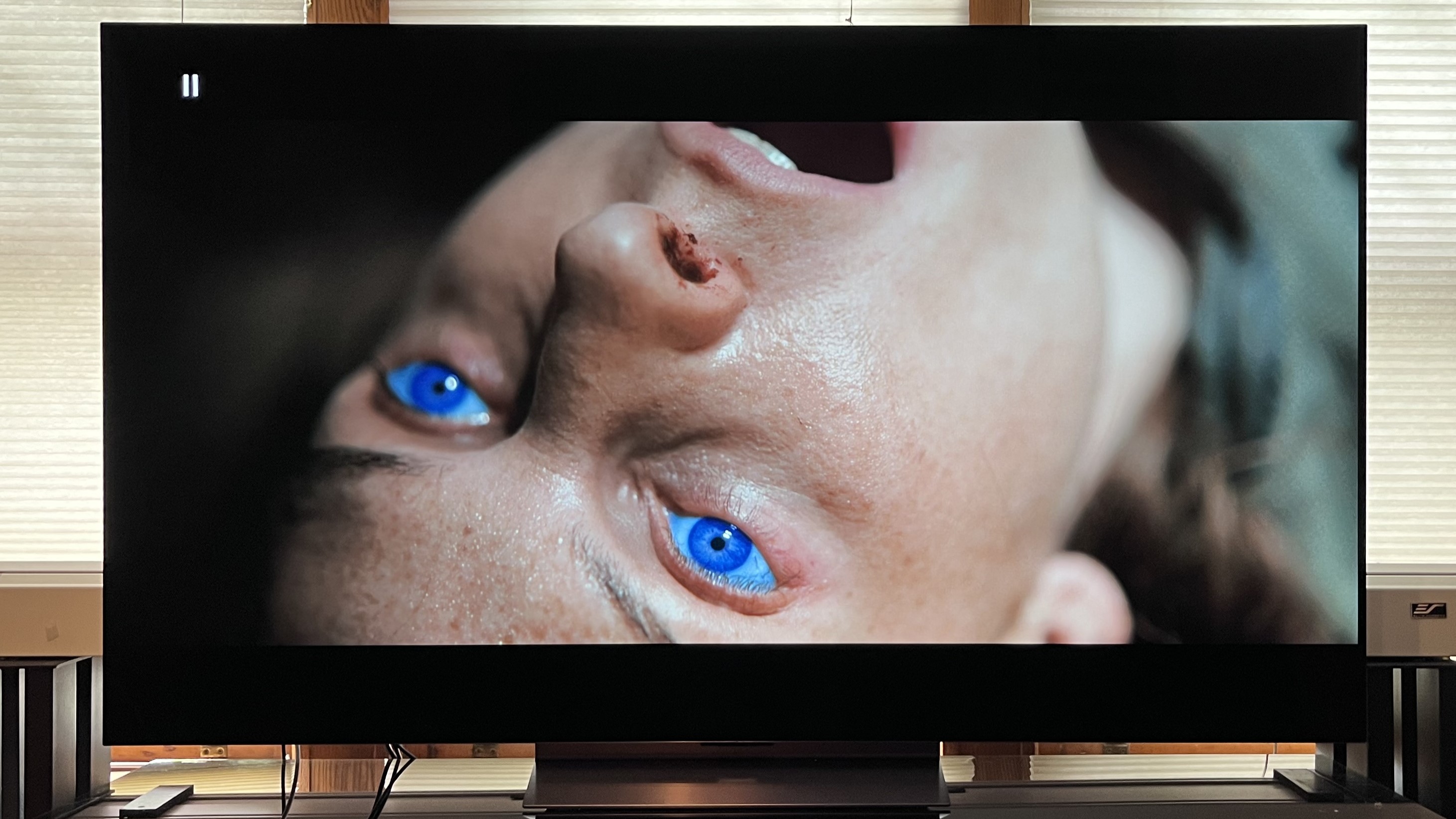
- Improved brightness over LG C3
- Excellent contrast and detail
- Anti-reflection screen
OLED TVs are generally getting brighter year after year, with some new flagship models such as the Samsung S95D managing nearly 1,700 nits peak brightness. With the LG C4 in Filmmaker Mode, peak HDR brightness measured on a white window test pattern covering 10% of the screen area was 1,065 nits, and a full-screen pattern measured 202 nits. Both of those results show an improvement on last year’s LG C3, which managed 830 and 163 nits respectively on the same tests.
The LG C4’s UHDA-P3 color space coverage in Filmmaker Mode was 98.7% and BT.2020 coverage was 72.7%. Once again, those are excellent results that are typical for the best OLED TVs. The averaged Delta-E values that determine grayscale and color accuracy (see “How I tested” section for details) were 2.9 and 1.5, respectively. Those numbers are both below the threshold we typically look for TVs to hit (a good thing), and with 2-, 10-, and 22-point grayscale adjustments, the LG C4 offers plenty of range to further improve accuracy.
I typically watch at least some black-and-white movie scenes when testing TVs, but I found that the Netflix series Ripley, which was shot completely in black and white, made the most compelling case for the quality of the LG C4’s picture. The first two episodes make repeat mentions of Caravaggio, and Ripley’s carefully composed images mirror the Renaissance artist’s high-contrast painting style. The C4 did an excellent job of fleshing out detail in Ripley's shadowy scenes, and the wide range of subtle gray tones in virtually every shot was richly rendered.
The LG C4’s boosted HDR brightness over its predecessor helped to bring out highlight details such as light reflections on water in multiple scenes from Ripley. When I next watched a 4K Blu-ray of Dune: Part Two, I noted the same effect in glistening grains of desert sand. Fine textures such as the wrinkled face of the Reverend Mother in a scene where Lady Jessica drinks the Water of Life came across with a high level of clarity, and although Dune: Part Two tends toward a monochromatic look, in the few instances where color is used such as when Lady Jessica’s eyes turn blue after the ceremony, it came across as startlingly vivid.
Other scenes from Dune: Part Two posed challenges to the LG C4’s picture processing, and it passed with flying colors. There are multiple shots of Paul Atreides and Chani wandering through desert storms in dim light with sand whipping around. The C4 managed to display these in a noise-free manner, and without compromising the image’s fine-grained quality. Motion handling was similarly excellent. When I watched a scene from the James Bond film No Time to Die that I use as a reference for detecting motion judder and blur, the craggy hillside landscape Bond walked across looked impressively detailed and solid.
While OLED TVs usually trail behind mini-LED models for daytime viewing, I found that the C4 looked satisfyingly bright even with overhead lights turned on. LG’s mid-range OLED may not be capable of hitting the same high brightness peaks as Samsung’s flagship, but its image retained a punchy quality even when competing with other light sources in the room. More importantly, its screen did a great job of filtering out light reflections, which allowed dark images to retain a high contrast level even with room lights turned up.
- Picture quality score: 4.5/5
LG C4 OLED TV review: Sound quality
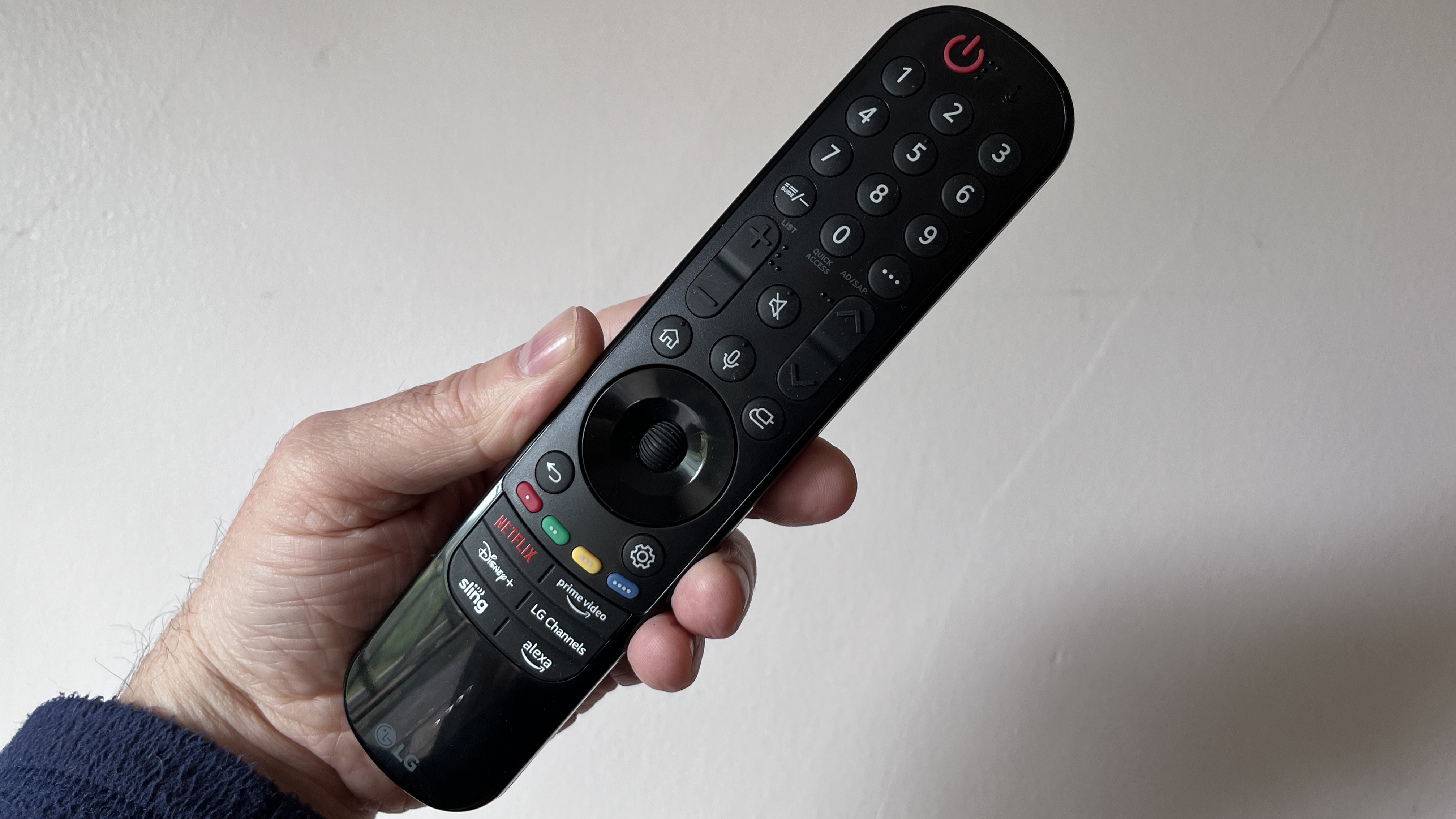
- 2.2-channel Dolby Atmos speaker system
- Enhanced features with LG soundbars
- Good overall sound but limited bass
The LG C4’s built-in 2.2-channel speaker system is powered by 40 watts. There’s support for Dolby Atmos and DTS:X (via pass-through), and an AI Sound Pro mode provides virtual 9.1.2-channel upmixing of soundtracks.
Several advanced audio features are unlocked when the C4 is paired with a compatible LG soundbar system. The first is Wow Orchestra, which combines the output of the TV’s built-in audio with the soundbar’s speakers for an enhanced audio presentation. Another key feature is Wow Cast, which allows for lossless wireless Dolby Atmos transmission from the TV to the soundbar.
The C4’s sound when watching movies was good overall, with clear dialogue and a decent level of spaciousness, especially when AI Sound Pro mode was active. I left this mode on for most viewing and generally found it to be the best option. As with many built-in TV speakers, bass is limited, and the dynamics get compressed when you watch movies at a louder volume, so adding one of the best soundbars to the LG C4 is a recommended option.
One special feature for music fans is the LG C4’s ability to play music tracks in Dolby Atmos from the TV’s Apple Music app. This feature is unique to LG TVs at present, so if you’re an Apple Music subscriber it’s well worth checking out.
- Sound quality score: 4/5
LG C4 OLED TV review: Design
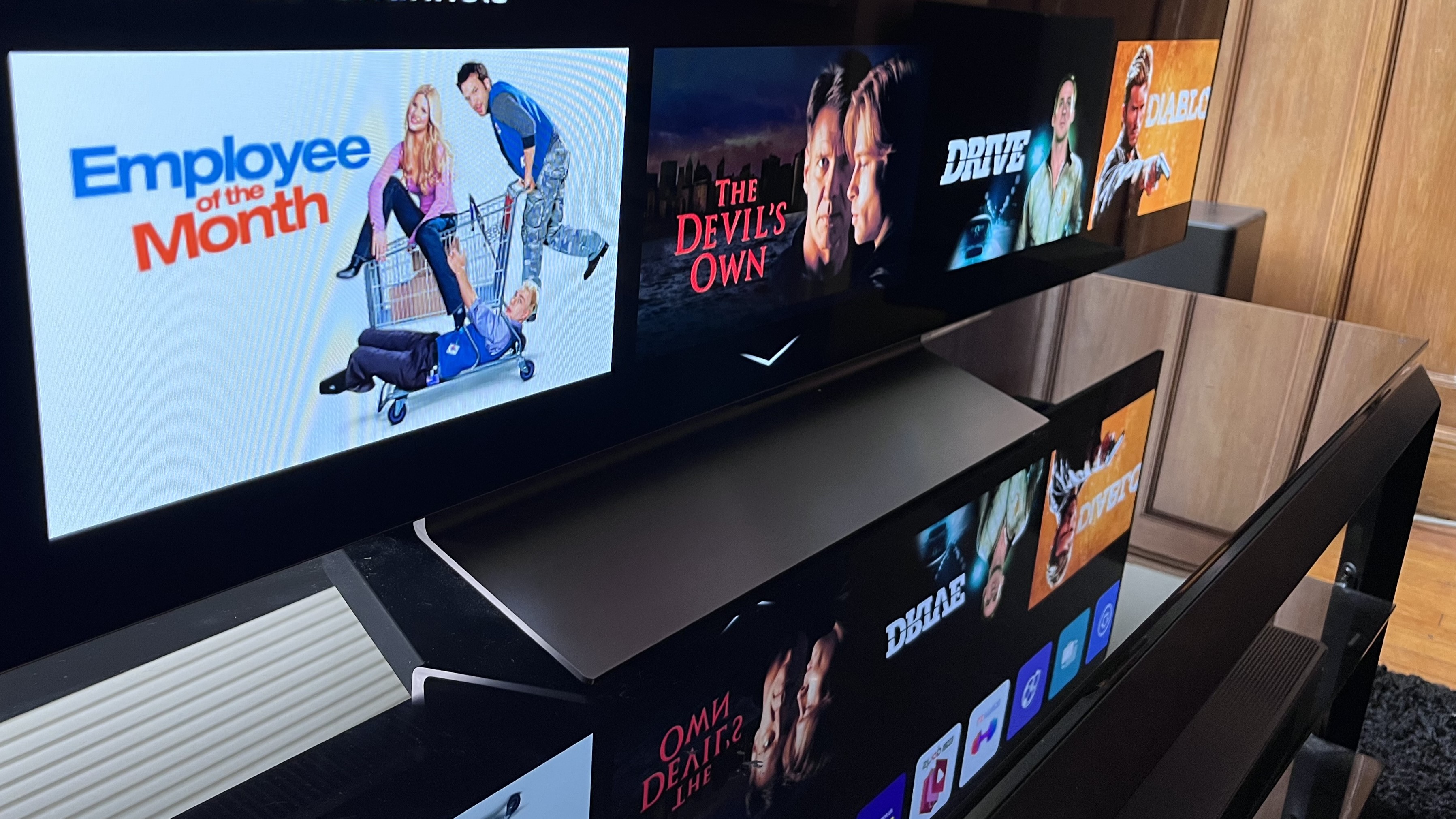
- Aluminum pedestal stand
- Magic Remote with point-and-click capability
- Hands-free voice control option
The LG C4 carries over the same design as 2023’s LG C3, with a lightweight composite fiber construction and a sturdy aluminum pedestal stand. The bezel framing the screen doesn’t have the same thin, “nearly invisible” look as higher-end sets such as the LG G4, but LG’s design still keeps the focus on the picture.
Along with its HDMI and antenna connections, the C4 features RS-232 and Ethernet ports for control. There are also three USB ports and an optical digital output, and the HDMI 4 port supports eARC.
LG’s Magic Remote lets you either point and click on onscreen apps and menu selections or scroll through them more traditionally. Direct access buttons are provided for the Netflix, Prime Video, Disney Plus, Sling, and LG Channels apps, and there’s also one to activate Alexa. A centrally located button provides access to the built-in mic for voice commands when pressed, and the TV also supports hands-free voice control.
- Design score: 4.5/5
LG C4 OLED TV review: Smart TV and menus
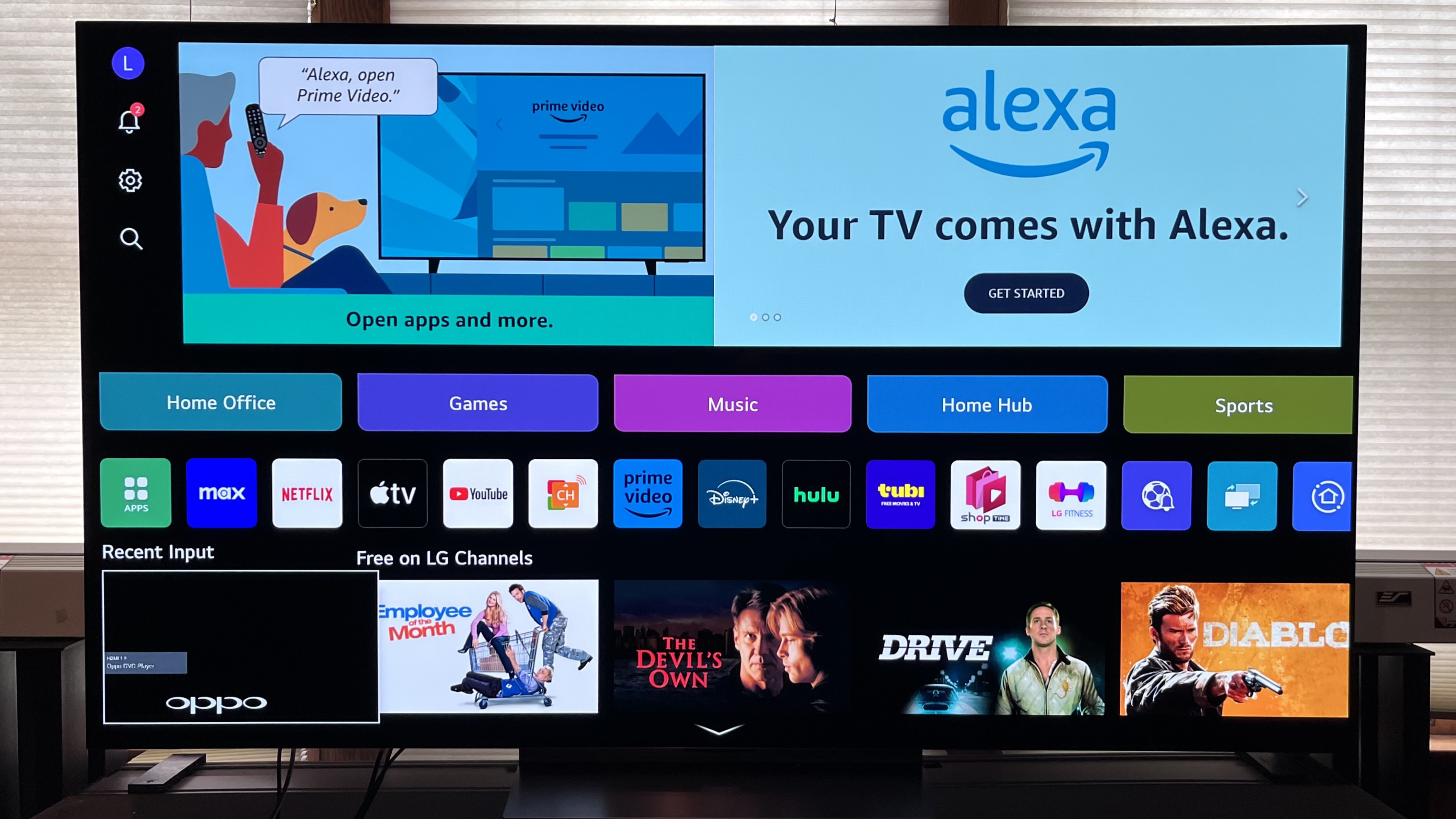
- Streamlined Quick Cards design
- Can edit order of apps on home screen
- Quick Menu makes setup easy
LG’s new WebOS 24 smart TV interface includes a few design tweaks, with some positive changes, and others that are not so great. The Quick Cards section, which features Games, Music, Home Hub, Sports, and Home Office options for storing related apps and accessing settings, now has a more streamlined look. Home Hub lets you configure Matter-supported devices for control on the TV, and when using it I was able to set up my Nanoleaf smart lights so the TV could turn them on and off. Another plus is that the row of apps that cuts horizontally across the screen can be edited, with the option to rearrange the order of apps and delete specific ones entirely.
LG’s streamlining of sections on the home screen was likely done to make space for other elements, and they prominently include recommended content on the LG Channels free ad-supported TV platform. The screen’s top section also now includes ads, though that’s something common on smart TV platforms, so LG isn't alone there.
The TV’s Quick Menu, accessed by pressing the gear icon on the remote control, lets you easily switch picture and sound settings, with more in-depth adjustments available within each option. There is also an onscreen chatbot available to help diagnose issues with the TV and get help, and you can set up voice recognition, which allows the TV to display personalized content recommendations on the home screen.
- Smart TV & menus score: 4.5/5
LG C4 OLED TV review: Gaming
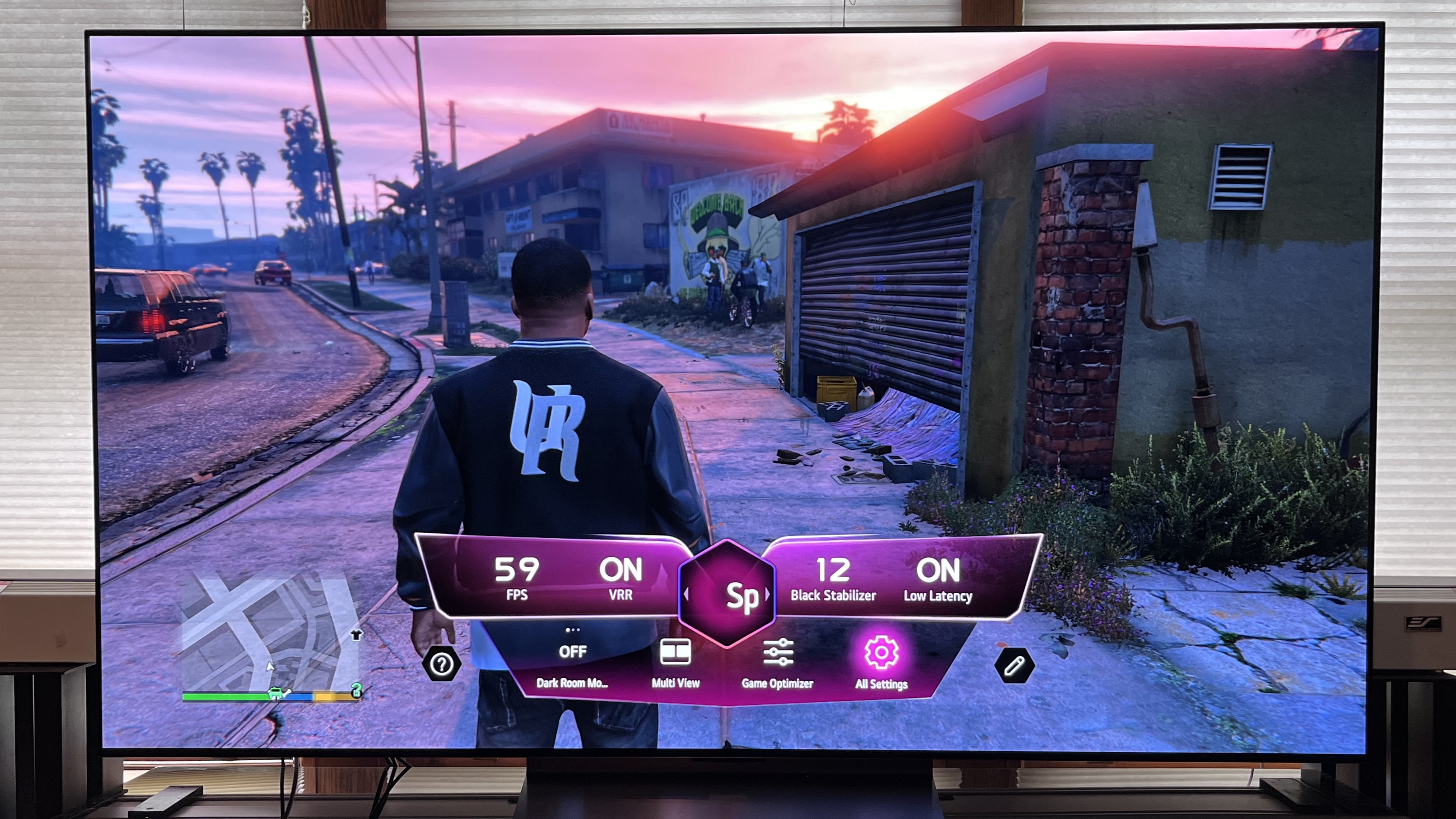
- 144Hz-certified for gaming
- Cloud-based gaming from GeForce Now and other services
- Low 9.2ms input lag (Boost mode)
The LG C4 has excellent gaming support. Its four HDMI 2.1 ports support 4K 120Hz pass-through, along with Nvidia G-Sync, AMD FreeSync, and 4K Dolby Vision gaming. LG’s 2024 OLED TVs, including the C4, are also the first 144Hz-certified TVs for PC gaming, with the certification carried out by Nvidia.
Clicking the Games Quick Card on the TV’s home screen calls up a range of cloud-gaming options from services such as GeForce Now, Amazon Luna, Utomik, Blacknut, and Boosteroid. A connected games console will also show up here as an option, giving you quick access to an Xbox Series X or PS5.
The TV can automatically switch to Game Optimizer mode when a console is connected. When active, pressing the gear icon on the remote calls up the game menu, which has options to make quick adjustments to genre and other gaming-related settings. With Game Optimizer on, input lag on the LG C4 measured 11.9ms, and dipped to 9.2ms after Boost mode was enabled.
- Gaming score: 5/5
LG C4 OLED TV review: Value

- Mid-range series in LG OLED lineup
- Excellent performance
- Premium design and features
At $2,699.99 / £2,699 / AU$4,299 for the 65-inch model I reviewed, the LG C4 is a fairly pricey TV. You can buy the company’s entry-level LG B4 OLED in the same screen size for $2,299, while the flagship LG G4 will set you back $3,399.
What are the differences between the three? The B4 lacks the C4’s OLED evo panel and Brightness Booster feature. And the G4 uses MLA tech and a Brightness Booster Max feature to deliver even higher peak brightness than the C4. Each model also uses a different processor, with the G4 stepping up to LG’s most advanced chip.
While it’s not LG’s priciest TV, the C4 is still a premium model with a premium design and features. You can buy mini-LED TVs with the same screen size for less than the LG C4, but the C4’s excellent picture quality and mid-range (for an OLED TV) price make it a very compelling choice.
- Value score: 4.5/5
Should I buy the LG C4 OLED TV?
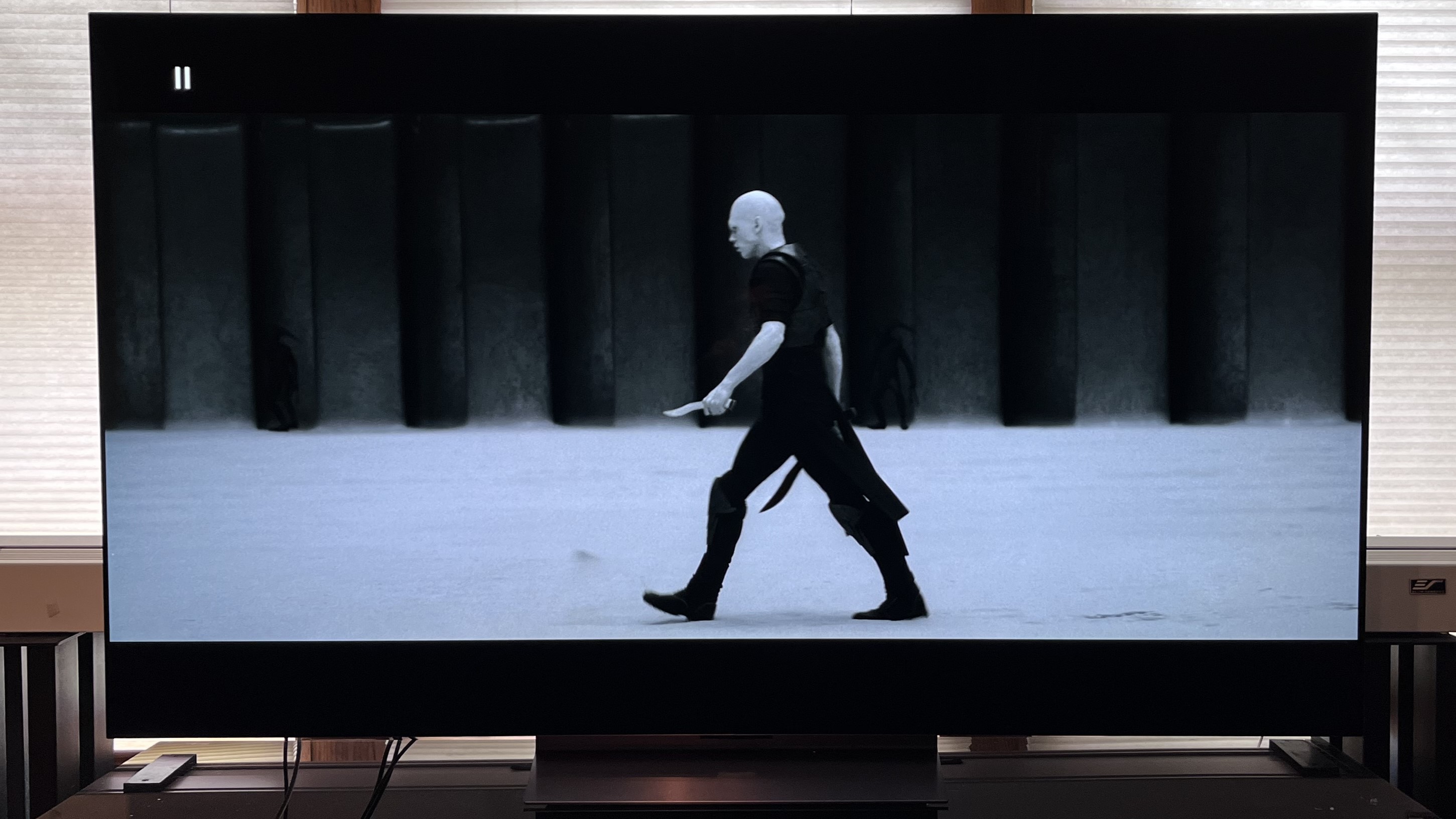
| Attributes | Notes | Rating |
|---|---|---|
| Features | A new processor with a Brightness Booster feature and new Dolby Vision Fillmmaker Mode | 5/5 |
| Picture quality | Great overall picture quality with above-average brightness for an OLED TV | 4.5/5 |
| Sound quality | Good overall sound quality with Dolby Atmos support, but limited dynamics and bass | 4/5 |
| Design | Sturdy build quality with aluminum pedestal stand and four HDMI 2.1 ports | 4.5/5 |
| Smart TV and menus | webOS 24 has a streamlined look with useful Quick Cards for storing apps | 4.5/5 |
| Gaming | Solid features including up to 144Hz support and cloud-based gamingg and up to 4K 240Hz support. | 5/5 |
| Value | It’s not cheap, but a very good overall value considering the performance and features | 4.5/5 |
Buy it if...
You want a great TV for gaming
The C4 has a fantastic range of gaming features, including up to 4K 144Hz support on four HDMI 2.1 ports, cloud-based gaming, and a useful onscreen game menu.
You want a “reasonably” priced OLED
While still not cheap, the LG C4 is priced less than flagship OLED TVs while providing premium features and performance
Don't buy it if…
You want the brightest possible OLED
Although the LG C4 is brighter than last year’s C3, it doesn’t match flagship models like the LG G3 or Samsung S95D when it comes to brightness.
You want the cheapest possible OLED
You can save money by buying LG’s B4 series model, which also has a great array of gaming features, but a lower brightness OLED panel and less sophisticated processing.
Also consider...
| Header Cell - Column 0 | LG C4 | Samsung S90C | LG G3 | Samsung S95D |
|---|---|---|---|---|
| Price (65-inch) | $2,699.99 / £2,699 / AU$4,299 | $2,099 / £2,499 / AU$4,299 | $3,999 / £3,999 / AU$6,995 | $4,599 / £4,599 / AU$7,995 |
| Screen type | OLED | OLED | MLA OLED | QD-OLED |
| Refresh rate | 120Hz | 120Hz | 120Hz | 144Hz |
| HDR support | Dolby Vision/HDR10/HLG/HDR10+ | HDR10/HLG/HDR10+ | HDR10/HLG/Dolby Vision | HDR10/HLG/HDR10+ |
| Smart TV | webOS 24 | Tizen | WebOS23 | Tizen |
| HDMI ports | 4 x HDMI 2.1 | 4 x HDMI 2.1 | 4 x HDMI 2.1 | 4 x HDMI 2.1 |
Samsung S90C
The Samsung S90C, the company's mid-range OLED TV, uses a QD-OLED panel for enhanced brightness and color depth. It has around the same peak brightness as the LG C4 and is also packed with gaming features. Here's our Samsung S90C review. We expect to test the new Samsung S90D soon.
LG G3
With its Micro Lens Array technology, LG’s flagship (4K) OLED TV for 2023 raised the OLED bar to a new level, especially for brightness. Here's our LG G3 review. We expect to test the new LG G4 soon.
Samsung S95D
Samsung's top OLED TV for 2024 hits a new OLED brightness peak and features a glare-eliminating screen that lets you view in brightly lit rooms without distracting reflections. Here's our five-star Samsung S95D review.
How I tested the LG C4 OLED TV

- Tested over the course of two weeks
- Measurements were made using Calman color calibration software
- A full calibration was made before proceeding with subjective tests
When I test TVs, I first first spend a few days or even weeks using it for casual viewing to assess the out-of-box picture presets and get familiar with its smart TV menu and picture adjustments. I next select the most accurate preset (usually Filmmaker Mode, Movie or Cinema) and measure grayscale and color accuracy using Portrait Displays’ Calman color calibration software. The resulting measurements provide Delta-E values (the margin of error between the test pattern source and what’s shown on-screen) for each category, and allow for an assessment of the TV’s overall accuracy.
Along with those tests, I make measurements of peak light output (recorded in nits) for both standard high-definition and 4K high dynamic range using 10% and 100% white window patterns. Coverage of DCI-P3 and BT.2020 color space is also measured, with the results providing a sense of how faithfully the TV can render the extended color range in ultra high-definition sources.
For the LG C4, I used the Calman ISF workflow, along with the TV’s advanced picture menu settings, to calibrate the image for best accuracy. I also watched a range of reference scenes on 4K Blu-ray discs to assess the TV’s performance, and 4K HDR shows streamed from Max, Netflix, and other services.
You can read an in-depth overview of how we test TVs at TechRadar at that link.
- First reviewed: June, 2024
- Read TechRadar's reviews guarantee

Al Griffin has been writing about and reviewing A/V tech since the days LaserDiscs roamed the earth, and was previously the editor of Sound & Vision magazine.
When not reviewing the latest and greatest gear or watching movies at home, he can usually be found out and about on a bike.
